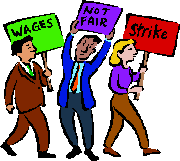by José A. Cruz
People's World
"Today we declare a State of Peaceful Insurrection of the people of Puerto Rico", declared Juan Vera, Methodist bishop of Puerto Rico, as he called for going from "protests to resistance to civil disobedience" against the neoliberal economic policies of Gov. Luis Fortuño which have resulted in the laying-off of 25,000 public sector employees. Fortuño had announced earlier this year that the number of government workers to be dismissed from their jobs would reach 30,000. Puerto Rico normally suffers from double-digit joblessness during non-recessionary times.
An estimated 100,000 plus marched from seven points in the San Juan metropolitan area to a massive rally at the Plaza de las Américas shopping mall which was chosen as the rally point because it is seen as a symbol of transnational corporations and its culture of consumerism. Hundreds were already at the starting points before the sun was up.
The owners of Plaza de las Américas announced the day before that the mall, the largest in the Caribbean and one of the largest in all of Latin America, would be closed the day of the strike. Strike leaders had threatened to close it down with massive picket lines.
The march was organized by the coalition All Puerto Rico for Puerto Rico, composed of labor unions, churches, civic, community and political groups. The protestors consisted of people from all political groupings, even those who voted for Fortuño. When the governor first announced his plans for lay-offs, members and local leaders of his own party, the annexationist New Progressive Party, told the press that even though they worked to get out the vote for him, they would protest his economic decisions.
Roberto Pagán, president of the Puerto Rican Union of Workers, said "today is the end of Luis Fortuño". Another Puerto Rican labor leader, Federico Torres, said he would put the number of people in the march at 200,000.
The most prominent symbol in the march which marked a one-day general strike organized by a coalition of labor, political, religious and civic organizations was the Puerto Rican flag being waved by thousands amidst union banners, and signs by different constituencies.
The mayors of 30 of the 78 municipalities helped organize almost 200 buses to the march.
Among the two biggest union contingents one can see in the march were UTIER, the electrical workers union, and the Puerto Rican Federation of Teachers (FMPR). They were joined by other Puerto Rican and US-based unions as well as church groupings, political and civic organizations.
Victor Rodriguez, a member of the FMPR, said he saw the march was a "wave of indignation against [the governor's] attempt at privatization" of state services.
A young woman, interviewed by Radio WKAQ, who worked in providing services to "special needs communities" said the people were there "to stop the current administration's abuse against the country."
Delegations of US union leaders also came to take part in the march said José La Luz, a leader of the American Federation of State, County and Municipal Employees. Another US labor leader, Dennis Rivera of SEIU-1199 said the Service Employees International Union was "calling on US workers to express their solidarity with the Puerto Rican workers."
Meanwhile, a contingent of University of Puerto Rico students from the Law School and the School of Urban Planning took over the highway from San Juan to Caguas, sitting down to block all traffic. Students from the medical school soon later joined them. After some time police officials were able to negotiate with students opening one lane in each direction. Police reported that other roads in the metropolitan areas were heavy with traffic due to the protestors having taken up many of the adjacent streets. Journalists have reported that some drivers stuck on the highways have left their cars on the roads and joined the protest.
Religious organizations took part in the activities of the day. Lutheran, Presbyterian, Methodist and Catholic bishops, clergy and parishioners marched behind banners declaring their commitment to fight for social justice. One of the biggest groups was led by Bishop Rubén González of the Catholic Diocese of Caguas. Behind a banner which declared, "Solidarity is the charity of today" marched 2,000 believers.
Fortuño administration official tried to give the impression that the country and government were not hampered by a "few protestors" but had to admit later on that the impact was much more than that. Reports coming in from different municipalities said that many schools had to close down because large number of students, teachers and even principals didn't show up.
The strike and march was first being planned by the trade union movement starting last spring as the governor announced his economic plans.
From the Labor Commission of the CPUSA, updates, information, news, analysis, and organizing materials in solidarity with workers of the world.
Friday, October 16, 2009
Subscribe to:
Post Comments (Atom)


No comments:
Post a Comment